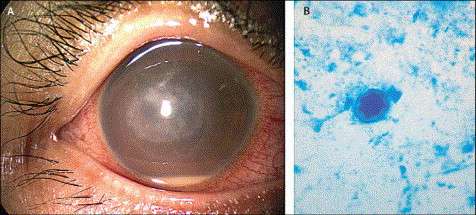Swimming with soft contact lenses: danger of acanthamoeba keratitis.
Yuichi, Beihua Hu, Keisuke Kawana, Tetsuro Oshika
ソフトコンタクトレンズをつけて水泳をするとアカントアメーバ角膜炎になる危険がある
25歳女性。右眼に突然の痛みとかすみを感じ医師の診察を受けた。初診ではヘルペス角膜炎と診断。全身と右眼に抗ウイルス剤と抗生物質を投与したが、効果は見られなかった。 彼女はスイミングのインストラクターをしていて毎日使い捨てソフトコンタクトレンズを装用し、ゴーグルをかけて水泳をしていた。 彼女が筑波大学病院に紹介されてきた時、目にはまだ刺激があり視力は手動弁(目の前で手を振って動いているのがわかるくらい)まで下がっていた。スリットランプ検査の結果、激痛の原因は角膜実質混濁による角膜の炎症であった。(写真A)角膜の中を真菌標本作製用コットンブルーで染色すると、二重壁のシストを持ったアカントアメーバが見つかった。(写真B)そしてアカントアメーバはスイミングプールの水の中からも検出された。ポリヘキサニド、アムホテリシンB、レボフロキサシンを局所的に投与して、1ヶ月後には角膜の炎症は減少したものの視力は手動弁のままだった。そして、1年間治療して角膜炎は回復し、彼女の視力は0.5にまで改善した。アカントアメーバは土壌、湧水、水道水といったあらゆる場所に存在する。それらは塩素にも抵抗力が強いのでスイミングプールの中でも存在しており繁殖できるのだ。しかし、スイミングで泳いでいる人たちのほとんどがアカントアメーバ角膜炎になるわけではない。むしろ罹患するのは稀である。なぜだろうか? その理由は、まばたきが角膜の表面にアカントアメーバが付着するのを防いでいるからだ。しかし、ソフトコンタクトをつけていれば、まばたきによるアカントアメーバ除去の効果はなくコンタクトレンズと角膜の間にそれらは存在し増殖することとなるのだ。ソフトコンタクトレンズを必要としている人はたくさんいる。そしてソフトコンタクトレンズを装用しながらスイミングプールで泳いでいる人達もたくさんいる。私たちは、アカントアメーバ角膜炎の患者を増やさない為にも、そのリスクや危険性について伝えていきたい。
(訳; 当院スタッフ 小野寺洋子)
A 25-year-old woman sought medical advice on experiencing sudden pain and blurred vision in her right eye. She has a swimming instructor and swam with daily disposable soft contact lenses and swimming goggles. The initial diagnosis was herpetic keratitis. Topical and systemic antibiotics and acyclovir were administrated but were ineffective. When referred to Tsukuba University Hospital, she had severe eye pain and visual acuity had decreased to hand motion. Slit-lamp examination revealed corneal stromal opacity due to severe corneal inflammation (figure,A). In a corneal biopsy specimen stained with cotton blue dry, double-walled cysts compatible with acanthamoebae were seen (figure,B). Acanthamoebae were also detected in the water of the swimming pool. Polyhexanide, amphotericin B, and levofloxacin were topically administrated. 1 month later, the corneal inflammation was reduced; however, visual acuity remained at hand motion. 1 year after treatment, the keratitis resolved and the patient’s visual acuity improved to 10/20. Acanthamoebae are found everywhere –eg, in soil, spring water, are swimming pools. Acanthamoebae are resistant to chlorine at its usual concentration in swimming pools, Thus, swimming pools could be breeding areas of acanthamoebae. Nonetheless, acanthamoeba keratitis is seldom contracted after swimming possibly because blinking inhibits acanthamoebae attaching to the corneal surface. However, once water goes into the goggles of swimmers using soft contact lenses, acanthamoebae may come between the soft contact lenses and the cornea. In such cases, acanthamoebae will not be removed by blynking, and the chance of Acanthamoebae keratitis increases. Soft contact lenses are indispensable to many people. A lot of people go swimming using soft contact lenses. We would like to make people aware of the risk of wearing soft contact lenses while swimming to reduce the number of patients with acanthamoeba keratitis.
Lancet infect Dis 2005; 5:392 YK, BH, KK, and TO are at the Department of Ophthalmology, institute of Clinical Medicine, University of Tsukuba, Tsukuba, Ibaraki, Japan
